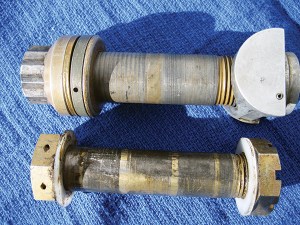November 3, 2025
Adapted from an article by Dean Benedict, published in the October 2025 issue of King Air Magazine.
Every so often, a story comes along that reminds us just how critical attention to detail is in aircraft maintenance. One such story involves a King Air 200 undergoing a routine five-year wing bolt inspection, a task that should have been straightforward, but ended in costly damage to both spars.
During reinstallation, a technician mistakenly installed the specialized nuts backward and torqued them down, on both sides. The unique half-moon shaped nut on this style of wing bolt is designed to nestle into a concave fitting on the spar, creating a precise curvature match that’s nearly “Murphy-proof.” Yet, as Dean Benedict shared in King Air Magazine, even the most foolproof designs can fail when the manual isn’t followed. The resulting damage was irreparable, requiring complete spar replacement, a rare and expensive lesson learned.

Photo credit: Dean Benedict/King Air Magazine
Understanding Wing Bolt Designs: Tension vs. Shear
King Air wing bolts serve one of two purposes, tension or shear, depending on their position.
-
In tension bolts are installed perpendicular to the fuselage, parallel to the leading edge. The stress is lengthwise, much like stretching a bolt from both ends.
-
In shear bolts, however, lie parallel to the fuselage and are held by interlocking curved “fingers”, much like the hinge on a piano. These leave visible wear stripes along the bolt shaft over time.
Older King Airs had in-tension bolts throughout, but beginning with serial number BB-1193, Beechcraft switched the lower forward bolts to in-shear. These must always be replaced when removed; they’re never reinstalled. By contrast, in-tension bolts can be reinstalled after inspection and are now on a 20-year replacement schedule (extended from 15 years).
Preventive Maintenance and Lubrication
Regular preventive maintenance remains the backbone of airworthiness. After corrosion was discovered decades ago on a King Air wing bolt, Beechcraft introduced an annual lubrication requirement, a simple but powerful preventive step. Even though today’s bolts are made from Inconel rather than steel, yearly lubrication keeps corrosion at bay and ensures peace of mind.
Inspection intervals vary by model, but generally occur every three to five years. These inspections often include dye penetrant or eddy current testing, and many shops rely on non-destructive testing (NDT) specialists for accuracy. As Benedict noted, issues are rare when aircraft are well maintained, but neglected aircraft can quickly turn into costly cautionary tales.
Spar Straps and Historical Lessons
The conversation about wing bolt integrity dates back decades. After a severely corroded King Air 90 wing bolt led to an accident overseas, spar strap modifications emerged as an optional safety enhancement. Designed by Dave Saunders of Aviadesign, and later by Beech, these straps provided added strength but came with their own inspection challenges.
For aircraft equipped with spar straps, maintenance can be labor-intensive, particularly on Beech’s version, but they continue to serve as a testament to Beechcraft’s proactive engineering mindset.
The 1980 Airworthiness Directive
In 1980, after a cracked wing bolt nut was discovered on a 200 model, the FAA issued an Emergency Airworthiness Directive grounding all King Air 200s until compliance was achieved. With little time to act, shops scrambled to remove and replace the lower forward in-tension bolts, or follow an approved alternative: heat-treating and NDT testing existing parts.
Benedict recalled the scene vividly from his days at BeechWest in Van Nuys, where King Air 200s filled the ramp, parked nose to tail as teams worked around the clock. Interestingly, most of the inspected hardware passed without issue, but the experience prompted Beechcraft to switch those lower forward bolts to the in-shear design just a few years later. Since then, wing bolt concerns have largely faded into history.
Mistakes That Should Never Happen
Unfortunately, the recent incident wasn’t the only example of improper installation causing major damage. Benedict also recounted a C90 case where incorrectly stacked washers during reassembly resulted in severe spar damage. The manual clearly specifies the correct order of washers — some with rounded shoulders, others with square edges, and any deviation can introduce stress and cracking.
Mechanics, Benedict emphasizes, must always pay attention and read the manual carefully. Never assume the previous technician installed everything correctly. Verification before removal can prevent repeating past mistakes.
Safety Still Reigns
For more than half a century, the Beechcraft King Air has been celebrated for its exceptional safety record, a reputation built on sound engineering and conscientious maintenance. The rare cases of improper installation, while costly, only reinforce how vital it is to follow procedures to the letter.
As Benedict concludes, maintaining that legacy requires diligence on both sides, operators who prioritize preventive maintenance, and technicians who respect the manual’s precision. Together, they ensure that every King Air continues to live up to its well-earned reputation for safety.

